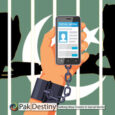
By Irum Saleem
“Back when I entered print journalism in Pakistan, the industry was small and vibrant. Other than Urdu, there were a handful of English-language newspapers but what they lacked in numbers they made up in purpose and impact. There was innovation enough to keep the readers interested,” writes Dawn’s columnist Arifa Noor.
“By the late 1990s, The News had introduced a colourful, political and comprehensive Sunday edition, which inspired others to follow suit. For instance, the fashion spread became a regular feature of the weekend edition. Later, Dawn introduced a comprehensive book review section and then another one on art. The Daily Times started covering private social events such as parties or weddings which proved to be a hit. It wasn’t long before other papers were doing this.”
News reporting was not ignored either. “Decades later, I can still remember the excitement of reading the parliament diary or extensive coverage of sectarian issues. Even during the 2005 earthquake, newspapers provided excellent coverage of the humanitarian crisis we faced. But this trend of innovation slowed down and more or less came to an end once television entered the media fray. Till the noughties, there was talk of the need to evolve as television took over the responsibility of breaking the news but the process of adaptation or evolution remained very slow in comparison. In fact, it rarely went beyond talk,” she writes.
محمد حنیف صاحب کا پنجابی ویلاگ🔥
— SIR Ahmed Khokhar (@khokhr_pedia) November 10, 2025
آخری بار پاکستان کو 1965 میں ایک عدد فیلڈ مارشل نصیب ہوا تھا 60 سال کے طویل انتظار کے بعد پاکستان کو ایک اور فیلڈ مارشل ملا ۔ نجانے اس عرصے میں پاکستان کیسے چلتا رہا ۔ ان 60 سالوں میں کوئی جنرل اس قابل نہیں تھا نہ ہی اتنا ٹلینٹڈ جتنا موجودہ آرمی… pic.twitter.com/GXi9Kzrieb
کل کے جمہوریت کے خودساختہ "چیمپئن" آج آمریت کے "چمپینزی" بنے ہوئے ہیں۔ پہلے 40 سال باری باری باغ کو کھایا اور اب مل کر باغ کو تباہ کر رہے ہیں۔
— Moonis Elahi (@MoonisElahi6) November 11, 2025
مفاہمت کے سرخیلوں نے اپنے ہی گھر پر پولیس کے ذریعے دھاوا بولا، چادر چاردیواری کا تقدس پامال کیا، چوہدری پرویز الہی کو ایک سال بدترین حالات میں جیل میں رکھا، گجرات کو سیاسی کارکنان کے لیے کربلا بنا کر رکھا، چوہدری خاندان کی خواتین سے غنڈوں کے ذریعے کاغذات تک چھین لیے، اور پھر… https://t.co/Jl1vYbjgFM
— Azhar Mashwani (@MashwaniAzhar) November 6, 2025
Perhaps the ad revenues for print shrunk; perhaps the journalists left for television’s greener pastures where salaries were better. Media owners too preferred a medium where the impact, as well as the bottom line, was greater. Whatever the reason, newspapers no longer remained a priority. And this happened as the electronic industry took over, around the time that Musharraf made an exit and the PPP and PML-N settled in.
Nearly two decades later, television’s fire and innovation are a thing of the past.
In those early days, television was the place of innovation and chaos, all at once. Television screens were full of quirky hosts and guests. But television was vibrant; there were shows where politicians took each other on but also prime time shows on religion and so much more. There were shows on social issues such as incest or rape. I have written before on how fascinated I was by Geo and Hina Bayat’s efforts in this category. And audience-based shows and documentaries. The fare included the successors to shows such as PTV’s 50-50, which were comprised of different skits and, reflecting the newfound freedom, mimicked politicians. The actors who played Zardari or Musharraf or Imran Khan on Hum Sab Umeed Se Hain were well known as was the author of the show. Political leaders back then didn’t take umbrage at these shows and neither were party heads sacred cows.
“Television was also edgy and so was the satire it offered. Begum Nawazish Ali, who invited people to her salon for interviews and a bit of a flirtation, took everyone by surprise. A man dressed up as a woman in a sari, she was such a sensation that politicians too weren’t averse to her invitation and some gave as good as they got. The begum was such a novelty in a conservative country battling extremism that she was profiled more than once in the Western press,” she says.
This is not to say that all was good. Talk shows often descended into shouting matches. Hosts got into the habit of speaking as much as the guests and then crossed the line as they covered the death and mayhem of the 2005 earthquake. But it was a new medium and back then we had hopes of evolving standards and red lines. The hope, in some cases, simply remained a hope.
Indeed, nearly two decades later, that initial fire and innovation are a thing of the past. It is hard to remember the last time that any news channel tried to innovate. The pattern is set — there will be news bulletins and the rest of the cycle will be talks shows — from seven to eight; eight to nine; 10 to 11; and then 11 to midnight. The last programme varies a bit from channel to channel, but the rest of the hours hardly do. In the other hours, politics dominates and a host asks questions of either one or two or three guests. And the guests too are more or less the same — across channels and across hours. We know in advance what each one will say and what line they will take.
“Social issues and documentaries are also in the past. So is the humour of the earlier years. Anything more innovative or original is not possible now. The morning and afternoon hours are when channels broadcast various press conferences — of mostly those in government in one place or the other because these are the people who have ads to offer,” Noor writes.
And this is rather reminiscent of the ennui that once afflicted print. It was hard to predict back then that this sense of comfort was simply leading the way into irrelevance. In hindsight, it seems hard to understand why there wasn’t more concern about it. And now, the electronic media is headed in the same direction. As with print, it seems we are at a similar moment where everyone in the medium is aware of the problems, the weaknesses and the disinterest of the audience but no one is willing to act. The comfort of sticking with the familiar is far too easy.
“So we talk about people turning to social media, which is providing information, innovation and perhaps more interesting content. There are documentaries, news, interviews, and it’s also able to evade the censorship which hobbles us. But television flexes its muscles at the big money coming its way and thinks the rest — credibility, audiences, staleness — doesn’t matter. But for how long? It might be too late, far too quickly,” Arifa Noor says.






